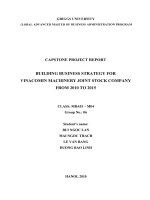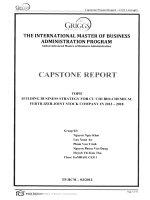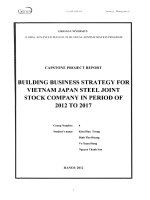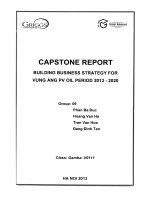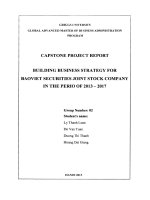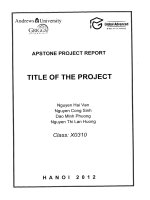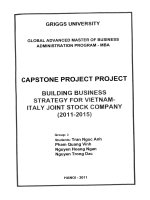Building business strategy for Son Kim Ha Tinh tourism and mineral water joint stock company from 2011 to 2015
Bạn đang xem bản rút gọn của tài liệu. Xem và tải ngay bản đầy đủ của tài liệu tại đây (1002.97 KB, 75 trang )
GRIGGS UNIVERSITY
GLOBAL ADVANCED MASTER OF BUSINESS ADMINISTRATION PROGRAM
BUILDING BUSINESS STRATEGY FOR SON KIM
HA TINH TOURISM AND MINERAL WATER
JOINT STOCK COMPANY
FROM 2011 TO 2015
Group: 10 - Class: GeMBA 01.V02
1. Võ Văn Hiệp - Leader
2. Nguyễn Xuân Hải - Member
3. Phan Thanh Hải - Member
4. Nguyễn Mẫu Lương - Member
HA NOI, 2010
Building Business Strategy for Son Kim Ha Tinh Toursim and Mineral Water
Joint Stock Company from 2011 to 2015
2
PREFACE
1. The necessity for research
Soft drinks business and bottled water industry in Vietnam has undergone a
process of formation and development from the late nineteenth century to the
present. The beverage industry is important, associated with the increasing demands
of society. Soft drinks business and bottled water industry has an important role in
the national economy. In 2007, industrial production value of mineral water
accounted for 12.66% of beverage industry production value and 2.69% of export
value of the whole industry. The sector contributed 2.3% to the government budget,
attracted over 14 thousand employees. Soft drink bottling industry has 1,013
enterprises with production capacity of 2,129 million liters per year. Especially
from 2007 to now, the industry maintains high growth speed, averaging over 14%
per year [
1
].
According to general assessment, the recent market shows a clear shift in the
bottled water industry. While carbonated soft drinks fell by 5% market share, the
industry is derived from natural and instant drink increased by 12%. Improvement
of living standard is premise to Vietnamese customers to care much more about the
health issues. Instead of "fully eat", today's consumers are towards "fine dining,
food safety” so health criteria placed on top of the food choices. Therefore,
consumers are now more aware of this convenient drink.
The contribution of the soft drink business and bottling industry to production
and added value is increasing. However, the current stage of development of the
soft drink and bottling industry in Vietnam reveals problems, such as generally low
product quality, lack of competition, and inadequate development plans. Besides,
there are still many small-scale beverages companies, patchwork investment, lack
of uniformity at many locals , resulting in no guarantee of quality, food hygiene and
[
1
] Nguyen, Q. (2010, June 3). Soft drinks business. Saigon Business , 52, 14.
Building Business Strategy for Son Kim Ha Tinh Toursim and Mineral Water
Joint Stock Company from 2011 to 2015
3
safety, state counterfeiting, unauthorized copying also cause damages to many
businesses and consumers.
During the integration process, the pressures that beverage business and
bottling industry face are very large. Under WTO commitments, the support from
the State sector will be reduced. Protection policy with abolished quotas, tariffs will
be reduced according to the schedule to make the beverage products from the
oversea to appear more in the domestic market and fiercely compete with domestic
products. This really is a big challenge because the domestic market is the major
consumption market of beverage business and bottling industry in Vietnam. Not
only having trouble in the "home market", the products when exported to other
countries might also be impeded by trade barriers such as regulations on technical
standards, quality, food hygiene and safety. These criteria is now rigorously
required while product quality by domestic manufactures is low, which leads to the
difficulties in consumption. It is said that the integration is open to a large market
for the industry, but to penetrate into these markets is not easy, especially in the
market with high requirements.
Contribution to the growth of drinks business and manufacturing industry,
mineral water is a typical product which the consumer is increasingly interested.
The serious competition within the industry affects to the competition of mineral
water’s bottlers. For each business enterprise fast and sustainable development in
the market requires every business must have a business strategy in the right
direction.
Son Kim Ha Tinh Tourism and Mineral Water Joint Stock Company
(SOKIMIWACO) is an enterprise producing natural mineral water with a capacity
of 5,000,000 liters per year, is a business and bottling company of mineral water
have a relatively large capacity in the areas of central provinces. However, in
recent years SOKIMIWACO activities may not actually realize its full performance
advantage of the business with precious natural resources.
Building Business Strategy for Son Kim Ha Tinh Toursim and Mineral Water
Joint Stock Company from 2011 to 2015
4
It is the fact that, SOKIMWACO has many restrictions and other factors
interfere.
- Firstly, in term of market, SOKIMIWACO faces severe competition from
bottlers of beverage and mineral water in Nghe An and Ha Tinh
provinces
- Secondly, SOKIMIWACO has not built any strategies, vision, and
mission yet. In other words, the company does not have any specific
operation objectives.
- Thirdly, products of the company in the past years still lacked quality,
revenue and profits were low, even in recent years remained unprofitable
- Fourthly, input factors for production of company are impacted by
subjective factors (material, fuel, plastic)
- Finally, mobilized funds for the production of SOKIMIWACO are still
difficulties, outdated technology and low labor productivity, management
level is still weak.
To assert competitive advantages and to help the company have long term
development direction, to build brand, a suitable business strategy for the Company
must be required.
With the above reasons, our group researched and recommended to build
business strategy for SOKIMIWACO during the period of time from 2011 to 2015.
2. Objectives and application of research
The main purpose of this study is to select a long-term development strategy for the
product of Son Kim natural mineral water based on assessment and environmental
analysis, the internal and external prospects of soft drink bottling industry during
the next five years. The specific objectives of the study are:
- Review the best model on development strategy of drinking water sector.
- Identify strengths, weaknesses, opportunities, and threats of
SOKIMIWACO.
Building Business Strategy for Son Kim Ha Tinh Toursim and Mineral Water
Joint Stock Company from 2011 to 2015
5
- Review the current situation of SOKIMIWACO to develop competitive
programs.
- Build development strategy from 2010 to 2015 for SOKIMIWACO.
3. Objects and scope of research
3.1. Objects
The object of study is the company, SOKIMIWACO. This is a joint stock
company that consists of two major shareholders: one is the economic corporation
company and People's Committee of Ha Tinh and the other shareholders are
employees of the Company.
3.2. Scope
The research scope of this topic is the production activities, current business
activities, and external environmental factors affecting the operation of the
Company. This topic was studied and analyzed within 6 weeks (from 01/8/2010 to
15/9/2010). The data used in the subject were collected from 2007 to present.
4. Research methodology
Three basic methods to build long term development strategy of
SOKIMIWACO are:
4.1. Research methods to the dossier: Information for this study came from several
sources including annual reports of SOKIMIWACO and other figures of the
mineral water industry.
4.2. Interview method: The authors of this theme have directly interviewed a
number of SOKIMIWACO key staff, chief of the sales branch, marketing staff, as
well as workers. The authors also discuss with the leaders of the company about the
current situation and the development orientation of SOKIMIWACO next years In
addition, customer questionnaires and evaluation statistics were also used at the
same time.
Building Business Strategy for Son Kim Ha Tinh Toursim and Mineral Water
Joint Stock Company from 2011 to 2015
6
4.3. Methods of applying the theoretical model:
Analysis of external factors includes analysis of PEST model, Five Competitive
Forces of M. Porter, analysis of internal factors, EFE, IFE, and SWOT matrixes
5. Research structure
This research includes three main parts
Part 1: Preface
Part 2: Content
- Chapter 1: Theoretical foundation and the fact of building business
strategy for SOKIMIWACO from 2010 to 2015.
- Chapter 2: Overview and analysis of the business environment of
SOKIMIWACO.
- Chapter 3: Selection of development strategy for SOKIMIWACO.
Part3: Conclusion and recommendations
Building Business Strategy for Son Kim Ha Tinh Toursim and Mineral Water
Joint Stock Company from 2011 to 2015
7
CHAPTER 1
THEORETICAL FOUNDATION AND THE FACT OF BUILDING
BUSINESS STRATEGY FOR HA TINH SON KIM TOURISM AND
MINERAL WATER JOINT STOCK COMPANY FROM 2011 TO 2015
The theoretical foundation discussed in this chapter includes:
Definition of strategy, business strategy
Analysis of PEST model and 5 forces of M. Porter
Analysis of functional-based internal factors
Internal and external factor combination matrix
Selecting the suitable strategy from the SWOT analysis
1.1 Definition of strategy
Business strategy has long been studied with many theories and concepts.
There are many views on the concept of strategy:
First point: Business Strategy is an art using tactics to succeed over the
competitors. This school of thought is common.
Second point: The school of thought said that strategy is the art of creating
competitive advantage. Michael Porter of the Harvard Business School said,
"Strategy is the art of building a solid competitive advantage to the defense"
Schools of thought of France said that "Strategy is the art that companies use
to combat competing for victory"
Third point: strategy is both plan and art; a good strategy going with good
structure will bring to success. This is an approach method of strategic
management [
2
], and we also have different definition on strategy such as:
In 1962 Chandler considered strategy as “The determination of the
objectives, basic long-term goals of the enterprise and the application of a sequence
of actions as well as the allocation of necessary resources to carry out this goal.” [
3
]
[
2
] Three points of view ( 2010, June). Strategy Administration. MBA course. p. 12.
Building Business Strategy for Son Kim Ha Tinh Toursim and Mineral Water
Joint Stock Company from 2011 to 2015
8
Quinn came in 1980 with the more general definition: "Strategy is the pattern
or plan to integrate the major objectives, policies, and action sequences into a
rigorously cohesive whole".
Later, Johnson and Schole redefined strategy in environmental conditions
having a lot of rapid changes: "Strategy is the long term direction and scope of an
organization to gain competitive advantage for organizations through the format of
its resources in a changing environment, to meet market demand and satisfy the
expectations of our stakeholders"
Strategy is divided into 3 levels:
Corporate level strategy: Addressing what businesses the organization will
operate?
Business level strategy: Addressing how to compete?
Functional level strategy: Addressing how important to implement function?
(for example: human resource, marketing strategy)
4
Today the strategy is commonly used as a factor to increase the possibility of
success while minimizing the possibility of failure.
In summary, although there are many viewpoints and different definitions of
strategy, this study's authors believe that this topic "business strategy is a series of
complicated activities, to mobilize source of organization to achieve a specific
purpose.”
1.2. PEST analysis and five competitive forces model of Michael Porter
1.2.1. PEST analysis: PEST analysis and five competitive forces model of Porter is
to analyze the external factors acting on the enterprise and consider the impact on
business production operations of enterprises, to analyze the opportunities, threats
[
3
] Chandler, A. (1962) Strategy and Structure. Massachusetts: MIT Press
[
4
] Strategy definition (2010, June). Strategy management. MBA course. p. 20.
Building Business Strategy for Son Kim Ha Tinh Toursim and Mineral Water
Joint Stock Company from 2011 to 2015
9
for the existence and development of the business. PEST includes political,
economic, sociocultural, technological, and natural elements. [
5
]
The basic elements of the external environment are shown in the picture
below.
FIGURE 1.1 External factors of the enterprise
[
5
] PEST analysis and five competitive forces model of Michael Porter. (2010). Marketing and strategy
management documents. MBA course.
Political elements
Sociocultural
elements
Technological
elements
Economic
elements
Environmental
elements
EXTERNAL FACTORS
INTERNA
L
FACTORS
Building Business Strategy for Son Kim Ha Tinh Toursim and Mineral Water
Joint Stock Company from 2011 to 2015
10
Economic factors: The factors that play an important role in the factors
affecting the business activities of enterprises. It includes the following elements:
The economic growth, inflation, economic crisis, and personal income, and the gap
between the rich and the poor in society.
High economic growth, high personal income, and low inflation create
opportunities for businesses to invest. Conversely, low economic growth, low
personal income will be challenges for enterprises
Political factor: This factor covers political institutions, and the legal
system. Stable politics, the advantage of legal environment will be favorable
conditions for development business. Conversely, unstable political factors such as
frequent occurrence of war or internal disputes, restricted law will be challenges to
corporations
Concerning policy, Vietnam in recent years has been rated as a country with
political stability and has attracted foreign and domestic investors. In contrast,
neighboring Thailand in recent year often suffers internal disputes that cause
difficulties in economic development for Thai enterprises, especially in tourism
business.
Sociocultural factors: Social and cultural factors (tradition, habits, food &
drink culture, shopping culture) impact on market’s demand and this is an
opportunity for business to invest and develop. Technological factors: Today this
factor plays more important role, determining the business environment of the
business. The world is in the evolution of technology, a range of nascent
technologies and applications. It relates and impact on manufacturing companies,
service, banking (payment cards, ATMs )
Environmental factors: The factors such as climate, soil, and mineral
elements have impact on our business and production process. Environment with
moderate climate and country with many mineral resources brings opportunities for
business development while environments with severe climate and few mineral
resources create obstacles to business development.
Building Business Strategy for Son Kim Ha Tinh Toursim and Mineral Water
Joint Stock Company from 2011 to 2015
11
Integration factors: In addition to these factors when studying the impact of
the external environment, factors of integration affecting the industry should be
considered. No one can deny the trend of globalization, and this trend is a challenge
for business to develop.
The PEST factors in the model are shown in the following diagram
FIGURE 1.2 PEST Analysis Frameworks
1.2.2. Analysis of the Five Forces of Michael Porter
The Five Forces of M. Porter are used to analyze external factors of
enterprises. The model has been widely applied to enterprises over the world.
Political factors
Political stability
Labor Law
Tax Policy
Legal system
Legal Environment
Economic factors
Change of GDP
The rate of economic
growth
Interest rates, inflation
Unemployment
Cycle economy
Personal income
Social factors
Population,
demographics
Distribution of national
income
Lifestyle
Intellectual, cultural
Customs and practice
Technological factors
Technology Detection
Speed of technology transfer
Government spending for R & D
Market for technology products
Building Business Strategy for Son Kim Ha Tinh Toursim and Mineral Water
Joint Stock Company from 2011 to 2015
12
Threats of new entrants
Bargaining power
of customers
Threat of substitute
products/services
Bargaining
power of
suppliers
New entrants
Rivalry
Competitive
intensity
Substitutes
Customers
Suppliers
Analysis of the business trading in a particular industry environment helps
businesses understand the opportunities and challenges which has specific impact
on enterprises
Five forces includes (1) Bargaining power of suppliers, (2) Rivalry, (3)
Threat of new entrants, (4) Bargaining power of customers, (5) Threat of substitute
products/ services. Each one of these five forces is under the influence of other
factors which should be studied to create a complete picture of competition in an
industry. The interactions between these five competitive forces create opportunities
and threats to businesses in the same industry are shown in the diagram below:
FIGURE 1.3 Five competitive Forces model
Rivalry
Rivalry must be determined with the specific information on names, high or
medium or low competitive levels. An industry with high levels of competition is
Building Business Strategy for Son Kim Ha Tinh Toursim and Mineral Water
Joint Stock Company from 2011 to 2015
13
forced to lower price, which threatens the enterprise’s revenue. These factors
determining the competitiveness of the sector includes growth of the sector, other
businesses, and their size, difficulty to withdraw from the industry, the difference in
products amongst industry.
Threat of new entrants
The ease with which new enterprises can enter an industry influences
competition. A lot of barriers reduces the threats of new entrants and increases the
chances to existing enterprises. Barriers includes economics of scale product
differentiation and loyalty to brands, distribution network, absolute cost advantages
Bargaining power of customers
The position of buyers is determined by factors influencing the relationship
between buyers and businesses. Enterprises review products and services to ensure
that they are unique or similar to the other enterprises’ in the market. In other
words, the Company determines position of product to buyers. In relative
relationship between enterprise and buyers, if customers are "weak", they buy the
company’s products and services at any level of price, companies are able to set the
price to increase revenue.
Bargaining power of suppliers:
Suppliers can determine higher price or lower product quality, which means
that suppliers are now “stronger” than enterprises. Specifically, the supplier will
exert stronger influence when the enterprise does not have many substitute products
in the market forcing enterprises to choose what is offered. Bargaining power of
suppliers comes when enterprise’s business field is not important to supplier;
suppliers have the advantage of specialized products that makes it difficult for
businesses to select a different provider instead; providers can engage in the same
industry to directly compete with the enterprise.
Threat of substitute products and services
According to M. Porter, substitutes are the products of competitors in other
industries with similar functionality to meet consumer demand for the same
Building Business Strategy for Son Kim Ha Tinh Toursim and Mineral Water
Joint Stock Company from 2011 to 2015
14
customer. The existence of products which come from the unspecialized industry
increase general tendency to switch to alternative choices such as the relative price
of alternative products, the level of awareness of differentiation, available products
in the market.
1.3. Functional analysis
Analysis of internal factors to detect strengths and weaknesses of enterprises to
develop proper targets and strategies maximize strengths and minimize weaknesses.
Internal factors analysis includes the followings:
Sales and marketing
Financial performance
Technology and production
Organizational structure and operations
Human resource
Research, development and information technology system
1.4. External and internal factors combination matrix
1.4.1. External factor evaluation matrix
Analysis of the factors results in external factor evaluation matrix (EFE).
Businesses often have ten external factors and analyzed through the below steps.
We provide basic factors in the following attached table (calculated based on a scale
of 4):
Step 1: List key factors for enterprise’s success.
Step 2: Determine weights from 0.0 (not important) to 1.0 (very important).
Total weights is 1.0
Step 3: Classify from 1 to 4 for each factor to see how the current strategy of
the business response to factors, where 4 is the best response, 3 is the
reaction above average, 2 is the average response and 1 is a less reaction.
Step 4: Multiple weights with the sort to determine mark for importance
Building Business Strategy for Son Kim Ha Tinh Toursim and Mineral Water
Joint Stock Company from 2011 to 2015
15
Step 5: Cumulatively add marks to determine the total.
TABLE 1.1 External factor evaluation matrix
No
External factors
Weights
Mark
Total mark
1
2
3
4
5
…
+
Policy change
Technology development
Competitive intensity
GDP Growth level
Consumption trend
…………………………
Total
1
External factors: List the factors affecting the enterprise, which drawn from
conclusion of the analysis of industry factors and the economy. Then, the factors
will be integrated in table of the most important factors. There are 10 or more
factors selected basing on enterprises.
+ Weights: shows the level of importance of factors in industry. Coefficient is often
used and sum of weights is 1
+ Rating: Be able to assess response of enterprises to the fluctuation of external
environmental factors. 4 is the best response, 3 is the reaction above average, 2 is
the average response, and 1 is a less reaction.
The highest point for an enterprise is 4.0 and the lowest one is 1.0. Mark 4 shows
that the enterprise well respond with current opportunities and threats from the
external environment. Other word, organization’s strategies maximize chances and
minimize challenges from outside. Mark 1 indicates that business strategy set up
does not take advantage of opportunities or avoiding external threats.
Scores above 2.5 are likely to respond to and below 2.5 is not able to respond
Building Business Strategy for Son Kim Ha Tinh Toursim and Mineral Water
Joint Stock Company from 2011 to 2015
16
1.4.2. Internal factor evaluation matrix
Internal factor evaluation matrix uses to summarize result of analysis, assess
strengths, weaknesses of factors affecting to internal activities of enterprise. The
process of building internal factor evaluation matrix is quite similar to external
factor evaluation matrix’s, only with a difference in step 3: It is classified as a1
point if that is the biggest weakness, 2 point for the smallest weaknesses. 3 point for
the smallest strength, and 4 point for the biggest strength.
TABLE1.2 Internal factor evaluation matrix
Order
Internal factors
Weights
Mark
Total mark
1
Labor force capacity
2
Task responsibility and degree
3
Marketing
Total
1.0
No matter how many IFE matrix elements, Total mark can be classified as
little as 1.0 to 4.0 is the highest. The total mark less than 2.5 shows weak
competitiveness and more than 2.5 indicates competitive ability
IE matrix integrated basing on EFE and IFE matrixes. We define the center point of
the circle and the scale-determined circle. Green light of centre point implies
growth area, yellow light is stable area, and red light is dangerous area. Proper
business strategy is chosen relying on enterprise’s position on IE matrix. The matrix
also helps enterprise understand its strategic position.
Building Business Strategy for Son Kim Ha Tinh Toursim and Mineral Water
Joint Stock Company from 2011 to 2015
17
1.5. SWOT matrix
SWOT analyzes strengths, weaknesses, opportunities, and threats. Analysis
of external factors helps enterprise identify opportunities and threats while analysis
of internal factors proposes strengths and weaknesses of organization. Analysis of
investment portfolio and core capabilities must present competitive advantages of
enterprise.
Identification of opportunities and threats through analysis of data on
environmental changes in the economic, financial, political, legal, social,
competition in markets where businesses are operating or want to penetrate.
Opportunities could include the potential for market development, market share,
near sources of raw materials and cheap labor with appropriate skills. Threats could
name as narrowed market, fierce competition, policy changes, political instability at
key market, and the development of new technologies and media make the
production line of enterprise becoming obsolete.
Concerning internal factors of enterprise, strengths include skills, resource
and competitive advantages such as talented executives, outstanding technology,
available cash, good image, large market share. While weaknesses reflect in
mistakes, shortcomings, limited factors of competitiveness. The weaknesses also
include inefficient distribution network, disclosed labor relationship, lack of
managers with international experience, and obsolete products.
Results of the SWOT analysis must be specific, accurate, practical, and
feasible for businesses to make the next steps such as strategy formulation, strategic
objectives setting, mechanisms to control external factors and internal strengths,
disability of outside threats and limitation of enterprise.
Process of developing a SWOT matrix consists of 8 steps:
Step 1: List external opportunities
Step 2: List external threats
Step 3: List main internal strengths
Step 4: List main internal weaknesses
Building Business Strategy for Son Kim Ha Tinh Toursim and Mineral Water
Joint Stock Company from 2011 to 2015
18
Step 5: Combine internal strengths with external opportunities to create SO
matrix
Step 6: Combine internal weaknesses with external opportunities to create
WO matrix
Step 7: Combine internal strengths with external threats to create ST matrix
Step 8: Combine internal weaknesses with external threats
TABLE1.3 SWOT matrix
Strengths – S
Weaknesses - W
Opportunities - O
1.
2.
Combined strategy
SO
Combined strategy
WO
Threats - T
1.
2.
Combined strategy
ST
Combined strategy
WT
We have the following combinations
SO: Use strengths to take advantage of opportunities
ST: Use strengths to avoid risk
WO: Joint venture
WT: Complementing each other
Besides, we are able to combine other strategies and small group.
Building Business Strategy for Son Kim Ha Tinh Toursim and Mineral Water
Joint Stock Company from 2011 to 2015
19
1.6. Basic competitive strategy
1.6.1 Cost leadership strategy: The same commodity is provided to customers
with the lowest price. Decrease in cost of input, application of sales networks to
eliminate some intermediaries lower cost of products to supply goods to final
customers with time-saving, convenience, and competitive price. Cost leadership
strategy is specifically applied through solutions such as: management of inputs and
inventories, tight management of production and savings process, production with
large scale, building mounted business chain, proper and scientific distribution
network.
6.1.2. Differentiation strategy: Products with different characters compared with
other products having the same function are supplied to customers. Differentiation
creates trust, goodwill for consumers who satisfy products being used.
Differentiation also brings the feelings of greater benefits than with the same
products so they are willing to pay at higher price for the product and preferred
brands.
6.3.1 Focused strategy: business focus to meet customer demand for a particular
group or focus on specific market segmentation such as geography, income, gender.
Building Business Strategy for Son Kim Ha Tinh Toursim and Mineral Water
Joint Stock Company from 2011 to 2015
20
CHAPTER 2
OVERVIEW AND ANALYSIS OF BUSINESS ENVIRONMENT OF SON
KIM HA TINH TOURISM AND MINERAL WATER JOINT STOCK
COMPANY
2.1. Overview of Son Kim Ha Tinh Tourism and Mineral Water Joint Stock
Company
Son Kim Ha Tinh Tourism and Mineral Water Joint Stock Company
(SOKIMIWACO) consists of the two general shareholders: the Economic
collaboration Corporation and the Ha Tinh Provincial People's Committee, and
other shareholders: employees of the company. Legal capital is contributed by 63%
of the economic cooperation corporation, 36% of the provincial People's
Committee, and 1% of employees.
Company name: Công ty Cổ phần Nước khoáng và Du lịch Sơn kim – Hà
Tĩnh
English Name: Son Kim Ha Tinh Tourism and Mineral Water Joint Stock
Company
Abbreviation name: SOKIMIWACO
Address: Kim Son commune, Huong Son district, Ha Tinh province
Phone number: 039. 3879 307 - 3879 322 Fax : 039. 3879 322
E-mail :
Wesite:
Logo & slogan:
Building Business Strategy for Son Kim Ha Tinh Toursim and Mineral Water
Joint Stock Company from 2011 to 2015
21
Products:
PET bottled natural mineral water 0.35 liter
PET bottled natural mineral water 0.5 liter
PET bottled natural mineral water 1.5 liter
PET bottled natural mineral water with gas 0.50 liter
Glass bottled natural mineral water with gas 0.50 liter
Big PET bottled natural mineral water 7.50 liter
Big PET bottled natural mineral water 20 liter
2.2.1. History and development of SOKIMIWACO
Founded in 1993 Son Kim bottled mineral water factory was under the
management of Ha Tinh Export and Import Investment Company. In 1999, Son
Kim bottled mineral water factory was transferred to the Ha Tinh export, business,
and mining company. The company renamed Ha Tinh Son Kim mineral water
Company owned Ha Tinh industrial Department.
According to Decision No. 2449/QĐUBND of Ha Tinh Provincial People's
Committee, Ha Tinh Son Kim mineral water Company was converted to a joint
stock company with the full name of Son Kim Ha Tinh Tourism and Mineral Water
Joint Stock Company on the 14
th
November, 2002.
SOKIMIWACO has two group shareholders. The first one is the Economic
Collaboration Corporation and the Ha Tinh Provincial People's Committee, and the
other is employees of the company.
The company has been fully operated in the form of a joint stock company
since 2002. Through the years from 2003 to 2007 the company encountered
difficulties on the market as well as the organization of production, was the year
the company also lost. The company now has vigorously transformation: business
meets and exceeds the designed capacity to dominate Nghe An and Ha Tinh
market, product quality has been improved step by step, growth rate also increases
above 30% per annual in recent years, revenue, profits of after year is higher than
the previous year.
Building Business Strategy for Son Kim Ha Tinh Toursim and Mineral Water
Joint Stock Company from 2011 to 2015
22
2.2.2. Functions and tasks
+ Production and business of natural mineral water
+ Tourism services business
+ Trading
2.2.3. Organizational structure
FIGURE 2.1 Organizational structure of SOKIMIWACO
2.2.4. Performance of manufacturing and business from 2007 - 2009
According to reports from the Plan Department of SOKIMIWACO, annual
growth rate is 156% in 2008, 150% in 2009, and 183% (estimated) in 2010
CONTROL BOARD
BOARD OF CHAIRMAN
BOARD OF EXCUTIVE
DIRECTOR
ADMINISTRATIVE
MANAGEMENT DEPT
FINANCIAL
DEPARTMENT
PLAN
DEPARTMENT
HA TINH SALES CENTER
PRODUCTION FACTORY
VINH SALES CENTER
SHAREHOLDER MEETINGS
Building Business Strategy for Son Kim Ha Tinh Toursim and Mineral Water
Joint Stock Company from 2011 to 2015
23
TABLE 2.1 Performance of manufacturing and business from 2007 - 2009
Order
items
Unit
2007
2008
2009
2010
1
Production
output
liter
2,682,000
4,197,000
6,310,000
9,616,000
2
Sales output
liter
2,662,000
4,109,000
6,100,000
9,000,000
3
Revenue
Million
VND
3,320
4,934
8,600
15,000
4
Net income
Million
VND
11,5
10,5
320
760
5
Tax
Million
VND
240
230
700
900
6
Employees’
income
1000
VND
1,250
1,688
2,350
2,800
(Source: From the reports of SOKIMIWACO’s Plan Department in 2009)
2.2. Analysis of internal environment of SOKIMIWACO
2.2.1. Sales and marketing
Marketing and sales is one of the important activities influencing on the
development of SOKIMIWACO. The analysis of primary activities includes
elements of sales, price policy, distribution network, after sales service and trade
promotion activities.
Strengths:
Labor force with experience, skills, and enthusiasm meets the demand of
sales activities; the number of staff is responsible for market activities accounts for
40% of companies. The company has dynamic sales policy with two branches to
focus on the sales. Thus, sales activity is increasingly specialized and efficiently
operates.
Building Business Strategy for Son Kim Ha Tinh Toursim and Mineral Water
Joint Stock Company from 2011 to 2015
24
The company sets reasonable and flexible price policy with high quality
products to serve target buyers with lower price than other competitors’ among the
water sector from 5 to 10%, often offers the promotion programs on the Holidays
and festival occasions, and for old customers and consumers with excessive output.
SOKIMIWACO has developed basic distribution network at the target market with
300 agents in Nghe An and 400 distributors in Ha Tinh. Policies of building
distribution network is frequently updated to adapt each market segment, and to
develop new market in Thanh Hoa and Hanoi.
Recently, the company often cares after sales services to maximize
customers’ benefits. The staffs visit sites to receive consumers’ feedback helping
enterprise approach customers’ needs and satisfy them.
Trade promotion activities have been many changes especially in the
advertising, such as advertising on television in Nghe An and Ha Tinh provinces,
local newspapers, economic magazines; advertising programmes on bus, leaflets,
banners, etc. Due to these advertising strategies, more and more customers know
the company's products. These activities also contribute to increase in sale revenue
and market share for SOKIMIWACO.
Sponsored programs and activities are often organized for festivals,
conferences and sports events of the two provinces of Nghe An and Ha Tinh, and
funding programs gratitude and anniversaries, major holidays are frequently carried
out.
In addition, on special holidays or anniversaries meaningful gifts such as
flowers, domestic equipment with “Son Kim Mineral Water” are given to potential
customers of the company.
Limitations:
Qualification of the salesperson is still limited (the rate of sales staff with BA
degree is low). The staff serves customer basing on experience without any basic
training and professional skills.
Building Business Strategy for Son Kim Ha Tinh Toursim and Mineral Water
Joint Stock Company from 2011 to 2015
25
Management process of price is not appreciated to make customers share
negative feedbacks., delivery is not timely, especially in summer when consumption
demand highly increases and business have no enough inventories and transport to
meet demand of market, time to deliver sometimes is late. Management of
distribution network is unscientific and unprofessional to maintain separated and
small sales systems. The company does not frequently classify and evaluate, and
control capacity of distributors and agencies, which add expense to deliver
productions, and quality of its distributors, agents are not high.
After-sales service has implemented, but it is not often and not systematic,
there are not enough good programs and quantitative to best meet customer needs,
lack of investment in communication means and advertising creates unattractive
advertisements which find difficult to make impression to buyers. Budget for
promotion of trade is still limited. Sales staff is not aware of responsibility, poor
reporting, and organizational culture.
Trade promotion programs are not paid much attention, so the results of
these activities are not good.
2.2.2. Analysis of financial resources
Authors use the financial data of 2008 and in 2009 for analysis. Collected
data about the financial performance of SOKIMIWACO in 2009 followed:
Accounting Balance Sheet (short version) on December 31
st
, 2009
TABLE 2.2 Accounting balance
Ending balance
Beginning balance
(Unit: million
VND)
ASSETS
A. Current Assets
2,321
1,683
- Cash
1,218
573
- Short-term receivables
123
169

